On March 30th, WonderCon attendees got treated to a bonus feature in a Spotlight panel with Ann Nocenti, Jim Lee acting as her interviewer. The two had so much shared history that they reminisced about the “good old days” at Marvel as well as plunging into the current artwork that most impresses them on their work for DC. The panel opened with a tone-setting description from Nocenti of her time as a Marvel writer and editor, “back in the day when Marvel Comics was so much fun”, when you could “smoke and drink and have guns in the office”. Lee confirmed that the gun in the office was an observable phenomenon, and Nocenti added by way of explanation that guns were needed for “reference”.
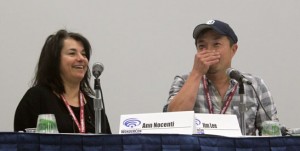 Lee started off by introducing Nocenti as the “self proclaimed female token writer at DC” and asked her how her current state came to be, considering that in her Marvel days there were several women on staff. Nocenti commented that though there were women at Marvel, she recalled that there were never any women at comic cons back then, unlike the demographic at WonderCon. “It must have been rough on you guys”, she teased Lee. Some of her workmates at Marvel, she explained, were Mark Gruenwald, “the soul of Marvel Comics”, Larry Hama, who was known for “pounding, crazy music” in his office, and Peter Sanderson, a “living archive” of all things Marvel.
Lee started off by introducing Nocenti as the “self proclaimed female token writer at DC” and asked her how her current state came to be, considering that in her Marvel days there were several women on staff. Nocenti commented that though there were women at Marvel, she recalled that there were never any women at comic cons back then, unlike the demographic at WonderCon. “It must have been rough on you guys”, she teased Lee. Some of her workmates at Marvel, she explained, were Mark Gruenwald, “the soul of Marvel Comics”, Larry Hama, who was known for “pounding, crazy music” in his office, and Peter Sanderson, a “living archive” of all things Marvel.
Nocenti obviously had fond memories of the bullpen days at Marvel, stating, “The physical bullpen made the place creative”. She had a steep learning curve upon arriving at Marvel with a fine arts background, and had a lot to learn under her first editor Jim Shooter, someone who she described as “having a beautiful sense of story” and who ingrained in her the need for a “can’t/must” moment of conflict for a hero. The maxim still holds true for Nocenti, she confirmed. “He’s right”, Lee said, “Conflict is one of the key things in drama”. “Louise Simonson also had a huge influence on me”, Nocenti added, a woman who had the “power to cloud men’s minds” according to legend, by infusing even her most severe criticisms with a “cheerful attitude”.
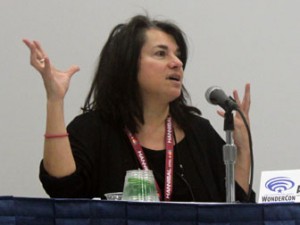 Nocenti shared some of the lessons she learned from editing at Marvel with the audience, including the need for the editor present a fan’s perspective to the writer or artist: “A good editor has to understand that a writer is working so hard, and is so over worked, that they need ideas thrown at them from a fan’s perspective”. But from the editor’s perspective, she observed, it often leads to bizarre conversations and often caused her to ask herself “Did I just say that?” when generating “wacky” ideas with writers. Nocenti particularly enjoyed crossover development in the bullpen, and feels that she wasn’t alone in that enthusiasm, sharing “really exciting creative meetings” where “everyone would want to play at the same party”. Her advice to editors is to “learn everything”, like a “captain knows how to run a ship”, and she feels that this approach was encouraged at Marvel, but is less common today. This enables an editor to “know what everyone’s going through”.
Nocenti shared some of the lessons she learned from editing at Marvel with the audience, including the need for the editor present a fan’s perspective to the writer or artist: “A good editor has to understand that a writer is working so hard, and is so over worked, that they need ideas thrown at them from a fan’s perspective”. But from the editor’s perspective, she observed, it often leads to bizarre conversations and often caused her to ask herself “Did I just say that?” when generating “wacky” ideas with writers. Nocenti particularly enjoyed crossover development in the bullpen, and feels that she wasn’t alone in that enthusiasm, sharing “really exciting creative meetings” where “everyone would want to play at the same party”. Her advice to editors is to “learn everything”, like a “captain knows how to run a ship”, and she feels that this approach was encouraged at Marvel, but is less common today. This enables an editor to “know what everyone’s going through”.
Lee presented Nocenti with a copy of a comic they had once collaborated on together, though she confessed she didn’t recall the book, X-Men #39. After flipping through it and chatting together, Nocenti declared, “This looks like a great story. I want to buy this and read this!”, to the audience’s amusement. Lee’s questions, however, led Nocenti into darker recollections, about the “mini implosion” period at Marvel that led to her departure. Ron Perlman, she narrated, came into her office one day, wanting to meet her, and was fairly charming, but the “next thing we knew, he had gutted Marvel” financially. It was a “very traumatic” experience for “old timers”, she commented, and brought to her attention a famous quote from Dorothy Parker: “Don’t put all your eggs in one bastard”. After leaving Marvel, Nocenti worked in journalism, teaching, and filmmaking, gaining a wealth of experience that she now finds useful for life back in comics.
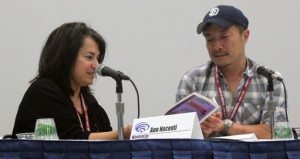 Writing a story about Catwoman in Arkham Asylum, for instance, she said, is drawn from a combination of her experiences working “at a place like Arkam” in her youth, and also from later editing Prison Life Magazine, which contained the work of prisoners. She observed a psychological feature that she’s incorporated into comics, the fact that it’s often “one small thing” that drives people crazy, not necessarily the bigger issues in life. Her experiences as a journalist and activist also led Nocenti to visit China, and some of her observations there led directly to her recent writing on GREEN ARROW, particularly noticing the pervasive “firewalls” on internet access in China and the sense of surveillance. Though she enjoyed working on GREEN ARROW, Nocenti explained that she “just couldn’t find her connection” to the character and was happy to move on to writing CATWOMAN, a character who she felt immediately in sync with. Her work on KATANA, too, keeps her imagination on its toes, drawing on the “idea of ancient clans, where the rich hire Samurais and ninjas are like spies”.
Writing a story about Catwoman in Arkham Asylum, for instance, she said, is drawn from a combination of her experiences working “at a place like Arkam” in her youth, and also from later editing Prison Life Magazine, which contained the work of prisoners. She observed a psychological feature that she’s incorporated into comics, the fact that it’s often “one small thing” that drives people crazy, not necessarily the bigger issues in life. Her experiences as a journalist and activist also led Nocenti to visit China, and some of her observations there led directly to her recent writing on GREEN ARROW, particularly noticing the pervasive “firewalls” on internet access in China and the sense of surveillance. Though she enjoyed working on GREEN ARROW, Nocenti explained that she “just couldn’t find her connection” to the character and was happy to move on to writing CATWOMAN, a character who she felt immediately in sync with. Her work on KATANA, too, keeps her imagination on its toes, drawing on the “idea of ancient clans, where the rich hire Samurais and ninjas are like spies”.
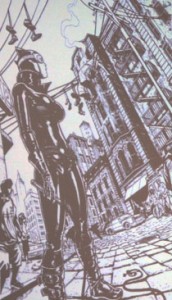 Lee and Nocenti spent the remainder of the panel showing and discussing process artwork and completed panels from upcoming CATWOMAN and KATANA stories, and enthusing over their finer features. The images included the set up for what Nocenti described as a “big gang war” for Catwoman and scenes in Arkham with “old torture devices”. Nocenti’s work on KATANA is based on her own obsession with martial arts and Kurasawa and martial arts films. “All comic book writers are doing really is unloading their personal obsessions on the page”, she confessed. This leads the writer to worry that readers might not find it interesting, she said, but in the case of Katana, Nocenti’s obsessions have translated to plenty of interest from fans. Nocenti regularly practises karate and judo around the house to see how Katana would move and act, and makes things even more “realistic” through watching martial arts films. It’s clear that her adaptable nature, shown throughout her varied career paths, is still going strong, and that her personal enthusiasm for her projects is still one of Nocenti’s most defining features.
Lee and Nocenti spent the remainder of the panel showing and discussing process artwork and completed panels from upcoming CATWOMAN and KATANA stories, and enthusing over their finer features. The images included the set up for what Nocenti described as a “big gang war” for Catwoman and scenes in Arkham with “old torture devices”. Nocenti’s work on KATANA is based on her own obsession with martial arts and Kurasawa and martial arts films. “All comic book writers are doing really is unloading their personal obsessions on the page”, she confessed. This leads the writer to worry that readers might not find it interesting, she said, but in the case of Katana, Nocenti’s obsessions have translated to plenty of interest from fans. Nocenti regularly practises karate and judo around the house to see how Katana would move and act, and makes things even more “realistic” through watching martial arts films. It’s clear that her adaptable nature, shown throughout her varied career paths, is still going strong, and that her personal enthusiasm for her projects is still one of Nocenti’s most defining features.
Photo Credits: All photos in this article were taken by semi-professional photographer and pop culture scholar Michele Brittany. She’s an avid photographer of pop culture events. You can learn more about her photography and pop culture scholarship here.
Hannah Means-Shannon writes and blogs about comics for TRIP CITY and Sequart.org and is currently working on books about Neil Gaiman and Alan Moore for Sequart. She is @hannahmenzies on Twitter and hannahmenziesblog on WordPress.
A panel on Friday, March 29th, the first day of programming at WonderCon brought together a rather iconic cast to discuss “iconic characters” and what keeps a character “true” to their origins over long periods of time. Mark Waid opened as moderator by pointing out that the table full of seasoned pros had more than 125 years of comics experience between them and most had worked on longterm characters and newer creations alike. The essential question posed by Waid was how to “vault” characters “into the 21st century without losing what keeps them special”. The question seemed particularly pertinent to Waid, whose ongoing work on DAREDEVIL has evoked critical acclaim. Waid asked his panellists how they handle the “core elements of characters” to face this challenge.
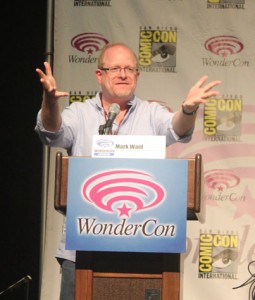 J. M. De Matteis introduced an image that stayed with the panellists as a reference point for discussion. He felt that creators handling long-lived characters work “within a cage”, so they can’t “go wide” with the character in term of change, but they can “go deep” in terms of making new discoveries. For De Matteis, personally, it’s all about the “Big Why” of characters, figuring out what makes them tick. He prefers working with super-villains to pose questions about the formative impact of their past histories because there’s “always a little corner of the psyche to dig into”. Ann Nocenti, however, in her recent work with Catwoman found that “her archetype was pretty clear” as a troubled kid originally, “on the streets” originally, and moving through “foster homes”. Her intuitive approach is to “play with a character and see what feels right” and she doesn’t mind the fact that later creators will do the same with long-term characters. It’s “like treading water”, she said, “You give a sense of constant, dynamic action, but you’re really not moving far”, and she expects later creators to be under the same constraint.
J. M. De Matteis introduced an image that stayed with the panellists as a reference point for discussion. He felt that creators handling long-lived characters work “within a cage”, so they can’t “go wide” with the character in term of change, but they can “go deep” in terms of making new discoveries. For De Matteis, personally, it’s all about the “Big Why” of characters, figuring out what makes them tick. He prefers working with super-villains to pose questions about the formative impact of their past histories because there’s “always a little corner of the psyche to dig into”. Ann Nocenti, however, in her recent work with Catwoman found that “her archetype was pretty clear” as a troubled kid originally, “on the streets” originally, and moving through “foster homes”. Her intuitive approach is to “play with a character and see what feels right” and she doesn’t mind the fact that later creators will do the same with long-term characters. It’s “like treading water”, she said, “You give a sense of constant, dynamic action, but you’re really not moving far”, and she expects later creators to be under the same constraint.
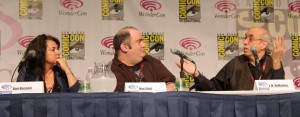 Doug Mahnke’s challenges, as an artist working on long-term heroes, is rather specific, handling costumes and their overtones. He observed that heroes, even today, often don’t look “contemporary” because their appearance has become iconic and we no longer question the anachronism, like Superman’s “underwear outside his pants”. Other features like capes and boots, Mahnke said, “made sense at the time” they were created based on a “swashbuckling” influence. In fact, he explained, an artist’s job is to “bring out the majesty in the character. It doesn’t matter so much what they’re wearing”, but you can use costume as a “tool” to use to your advantage.
Doug Mahnke’s challenges, as an artist working on long-term heroes, is rather specific, handling costumes and their overtones. He observed that heroes, even today, often don’t look “contemporary” because their appearance has become iconic and we no longer question the anachronism, like Superman’s “underwear outside his pants”. Other features like capes and boots, Mahnke said, “made sense at the time” they were created based on a “swashbuckling” influence. In fact, he explained, an artist’s job is to “bring out the majesty in the character. It doesn’t matter so much what they’re wearing”, but you can use costume as a “tool” to use to your advantage.
 Several of the panellists then commented on the fact that objectively, some of the nomenclature and costumes of characters created decades ago would seem “stupid” now. Nocenti’s example was a resurrection of a minor character, Zebra Man who was “visually fantastic” but the name and concept bizarre. Slott felt that once an icon is an icon, “the fact that it’s an icon gives it weight”, preventing further critique from readers. Even Waid’s considered opinion was that “Green Lantern” is a “stupid name for a character, but after 75 years”, it has “gravitas”.
Several of the panellists then commented on the fact that objectively, some of the nomenclature and costumes of characters created decades ago would seem “stupid” now. Nocenti’s example was a resurrection of a minor character, Zebra Man who was “visually fantastic” but the name and concept bizarre. Slott felt that once an icon is an icon, “the fact that it’s an icon gives it weight”, preventing further critique from readers. Even Waid’s considered opinion was that “Green Lantern” is a “stupid name for a character, but after 75 years”, it has “gravitas”.
 The panel then tackled the question of when and how exactly a character becomes officially iconic, and they set the bar high on awarding this status. De Matteis opined that “nothing about the character idea makes it iconic. It’s the execution”, and not every character reaches this status despite reasonably strong storytelling behind them. Dan Slott interjected that it only takes “one writer and one artist to do it”, like Frank Miller on DAREDEVIL. The discussion often drifted into slap-stick commentary on the more absurd aspects of superhero lore like the possession of a super vehicle as an icon accoutrement. Nocenti provided the little known detail that Cat Woman’s car is known as a “Catillac”. Slott confessed to proposing in a “meeting with real adults” that Superman’s car should be known as “Superman’s Ford Taurus of Solitude” with disasterous results.
The panel then tackled the question of when and how exactly a character becomes officially iconic, and they set the bar high on awarding this status. De Matteis opined that “nothing about the character idea makes it iconic. It’s the execution”, and not every character reaches this status despite reasonably strong storytelling behind them. Dan Slott interjected that it only takes “one writer and one artist to do it”, like Frank Miller on DAREDEVIL. The discussion often drifted into slap-stick commentary on the more absurd aspects of superhero lore like the possession of a super vehicle as an icon accoutrement. Nocenti provided the little known detail that Cat Woman’s car is known as a “Catillac”. Slott confessed to proposing in a “meeting with real adults” that Superman’s car should be known as “Superman’s Ford Taurus of Solitude” with disasterous results.
Waid observed that some characters are iconic in pop culture without necessarily being long-lived, like Woody Woodpecker, who’s highly recognizable, but not a currently active character. Waid commented that the tendency toward merchandizing may encourage the slow-down or freeze of new developments in a character since “every character becomes a beach towel” in the end. The entire panel segued into a long and fairly serious discussion of Wonder Woman as a character and why she has, or has not, lived up to her iconic status in terms of actual comic storytelling.

Most felt, like De Matteis, that Wonder Woman comics have not always been “all that good”, nevertheless the character definitely qualifies as “iconic”. Waid had a fairly idiosyncratic theory behind why this is the case. He observed that there was a strong “sexual element” to the “first 10 years of the strip” that was later removed to render the character more “plain vanilla”, and that now, lacking that “x-factor of sexuality”, stories fail to live up to the early days (an issue, he said, he frequently discusses with Grant Morrison). Slott disagreed pointedly with Waid’s assessment. He instead blames the lack of verve in Wonder Woman comics to the fact that comics are essentially a “make dominated industry” that has not explored the “many angles of the character” sufficiently. Slott still feels that if the right team is put together, the stories can rise to iconic status again, without recourse to the “weird quirky bits”. His choice of phrase caused plenty of giggling among the panellists.
This led Waid to ask his panel how they decide what elements are most essential to a character, what continues to translate, and what can be left behind. De Matteis advised to “always approach the characters psychologically and emotionally” and not worry too much about the “other stuff”, and sometimes that psychological appeal can be found in lesser known characters. Nocenti commented that her current work on KATANA based on the strange but intriguing concept of a “girl with a sword” produced “good potential” for developing “obsessional love triangle” elements between herself, her murdered husband, and his murdering brother.“The less iconic a character, the more fun you can have!”, she enthused.
Slott agreed with Nocenti on this idea, up to a point. When you’re handling an iconic character, readers lose the fear that their reckless lifestyles will do them in, whereas if a character is “unknown”, “Everyone is worried”, wondering if they will survive from issue to issue. Slott and Nocenti shared an interesting moment of commiseration, albeit brief, about their mutual killing off of Spider-based characters, and the emotional reaction of fans. “Screw letters from emotional fans”, Slott concluded, laughing, but Waid intervened by informing the audience that he’s sure Slott “weeps himself to sleep at night with 6 year olds’ fan mail” over the death of Spider-Man .
 The panellists didn’t always find their subject matter easy to decipher, nor did they feel that there’s always an easy answer for why some characters “click” as icons and some don’t. Batman, particularly, has a mysteriously successful dynamic, they said. But some things do change. Waid observed that he “couldn’t have imagined a world where I walked down the street and everyone knew who Tony Stark was” until after the Iron Man films had been made. Waid suggested that iconic status for characters might be measured in the number of imitators who have sprung up. De Matteis returned to his general position that archetypal patterns determine iconic status, however. Slott provided examples, stating that Superman is like Hercules, Batman a being on a vengeance-quest, and Tony Stark is, too, iconic in formula, as a combination of “Man and Machine”, an icon that the world is ripe for right now.
The panellists didn’t always find their subject matter easy to decipher, nor did they feel that there’s always an easy answer for why some characters “click” as icons and some don’t. Batman, particularly, has a mysteriously successful dynamic, they said. But some things do change. Waid observed that he “couldn’t have imagined a world where I walked down the street and everyone knew who Tony Stark was” until after the Iron Man films had been made. Waid suggested that iconic status for characters might be measured in the number of imitators who have sprung up. De Matteis returned to his general position that archetypal patterns determine iconic status, however. Slott provided examples, stating that Superman is like Hercules, Batman a being on a vengeance-quest, and Tony Stark is, too, iconic in formula, as a combination of “Man and Machine”, an icon that the world is ripe for right now.
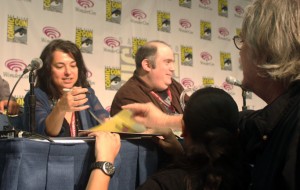 The panellists’ parting thoughts during the Q and A period focused on an interesting point made from the audience about the superhero/villain ratio. With so many more supervillains than superheroes in comics, “recycling” them is the norm, but at what point do they become “stale” and need to be retired, at least for awhile? De Matteis was firm about the roles of the artist and writers, insisting that there are “no stale characters but stale interpretations of characters” and that good work will prevent this problem. “Every character is great if you did into them in the right way”, he said. Waid’s closing example to support De Matteis’ point was that “20-25 years ago, no one would have thought that GREEN ARROW would become 2 times the best selling DC book, and then get his own TV show”. His bottom line: “If you dig deep enough you can find something that resonates”, and that’s the key to creating an icon, something that may not happen overnight.
The panellists’ parting thoughts during the Q and A period focused on an interesting point made from the audience about the superhero/villain ratio. With so many more supervillains than superheroes in comics, “recycling” them is the norm, but at what point do they become “stale” and need to be retired, at least for awhile? De Matteis was firm about the roles of the artist and writers, insisting that there are “no stale characters but stale interpretations of characters” and that good work will prevent this problem. “Every character is great if you did into them in the right way”, he said. Waid’s closing example to support De Matteis’ point was that “20-25 years ago, no one would have thought that GREEN ARROW would become 2 times the best selling DC book, and then get his own TV show”. His bottom line: “If you dig deep enough you can find something that resonates”, and that’s the key to creating an icon, something that may not happen overnight.
Photo Credits: All photos in this article were taken by semi-professional photographer and pop culture scholar Michele Brittany. She’s an avid photographer of pop culture events. You can learn more about her photography and pop culture scholarship here.
Hannah Means-Shannon writes and blogs about comics for TRIP CITY and Sequart.org and is currently working on books about Neil Gaiman and Alan Moore for Sequart. She is @hannahmenzies on Twitter and hannahmenziesblog on WordPress.
 Lee started off by introducing Nocenti as the “self proclaimed female token writer at DC” and asked her how her current state came to be, considering that in her Marvel days there were several women on staff. Nocenti commented that though there were women at Marvel, she recalled that there were never any women at comic cons back then, unlike the demographic at WonderCon. “It must have been rough on you guys”, she teased Lee. Some of her workmates at Marvel, she explained, were Mark Gruenwald, “the soul of Marvel Comics”, Larry Hama, who was known for “pounding, crazy music” in his office, and Peter Sanderson, a “living archive” of all things Marvel.
Lee started off by introducing Nocenti as the “self proclaimed female token writer at DC” and asked her how her current state came to be, considering that in her Marvel days there were several women on staff. Nocenti commented that though there were women at Marvel, she recalled that there were never any women at comic cons back then, unlike the demographic at WonderCon. “It must have been rough on you guys”, she teased Lee. Some of her workmates at Marvel, she explained, were Mark Gruenwald, “the soul of Marvel Comics”, Larry Hama, who was known for “pounding, crazy music” in his office, and Peter Sanderson, a “living archive” of all things Marvel. Nocenti shared some of the lessons she learned from editing at Marvel with the audience, including the need for the editor present a fan’s perspective to the writer or artist: “A good editor has to understand that a writer is working so hard, and is so over worked, that they need ideas thrown at them from a fan’s perspective”. But from the editor’s perspective, she observed, it often leads to bizarre conversations and often caused her to ask herself “Did I just say that?” when generating “wacky” ideas with writers. Nocenti particularly enjoyed crossover development in the bullpen, and feels that she wasn’t alone in that enthusiasm, sharing “really exciting creative meetings” where “everyone would want to play at the same party”. Her advice to editors is to “learn everything”, like a “captain knows how to run a ship”, and she feels that this approach was encouraged at Marvel, but is less common today. This enables an editor to “know what everyone’s going through”.
Nocenti shared some of the lessons she learned from editing at Marvel with the audience, including the need for the editor present a fan’s perspective to the writer or artist: “A good editor has to understand that a writer is working so hard, and is so over worked, that they need ideas thrown at them from a fan’s perspective”. But from the editor’s perspective, she observed, it often leads to bizarre conversations and often caused her to ask herself “Did I just say that?” when generating “wacky” ideas with writers. Nocenti particularly enjoyed crossover development in the bullpen, and feels that she wasn’t alone in that enthusiasm, sharing “really exciting creative meetings” where “everyone would want to play at the same party”. Her advice to editors is to “learn everything”, like a “captain knows how to run a ship”, and she feels that this approach was encouraged at Marvel, but is less common today. This enables an editor to “know what everyone’s going through”. Writing a story about Catwoman in Arkham Asylum, for instance, she said, is drawn from a combination of her experiences working “at a place like Arkam” in her youth, and also from later editing Prison Life Magazine, which contained the work of prisoners. She observed a psychological feature that she’s incorporated into comics, the fact that it’s often “one small thing” that drives people crazy, not necessarily the bigger issues in life. Her experiences as a journalist and activist also led Nocenti to visit China, and some of her observations there led directly to her recent writing on GREEN ARROW, particularly noticing the pervasive “firewalls” on internet access in China and the sense of surveillance. Though she enjoyed working on GREEN ARROW, Nocenti explained that she “just couldn’t find her connection” to the character and was happy to move on to writing CATWOMAN, a character who she felt immediately in sync with. Her work on KATANA, too, keeps her imagination on its toes, drawing on the “idea of ancient clans, where the rich hire Samurais and ninjas are like spies”.
Writing a story about Catwoman in Arkham Asylum, for instance, she said, is drawn from a combination of her experiences working “at a place like Arkam” in her youth, and also from later editing Prison Life Magazine, which contained the work of prisoners. She observed a psychological feature that she’s incorporated into comics, the fact that it’s often “one small thing” that drives people crazy, not necessarily the bigger issues in life. Her experiences as a journalist and activist also led Nocenti to visit China, and some of her observations there led directly to her recent writing on GREEN ARROW, particularly noticing the pervasive “firewalls” on internet access in China and the sense of surveillance. Though she enjoyed working on GREEN ARROW, Nocenti explained that she “just couldn’t find her connection” to the character and was happy to move on to writing CATWOMAN, a character who she felt immediately in sync with. Her work on KATANA, too, keeps her imagination on its toes, drawing on the “idea of ancient clans, where the rich hire Samurais and ninjas are like spies”. Lee and Nocenti spent the remainder of the panel showing and discussing process artwork and completed panels from upcoming CATWOMAN and KATANA stories, and enthusing over their finer features. The images included the set up for what Nocenti described as a “big gang war” for Catwoman and scenes in Arkham with “old torture devices”. Nocenti’s work on KATANA is based on her own obsession with martial arts and Kurasawa and martial arts films. “All comic book writers are doing really is unloading their personal obsessions on the page”, she confessed. This leads the writer to worry that readers might not find it interesting, she said, but in the case of Katana, Nocenti’s obsessions have translated to plenty of interest from fans. Nocenti regularly practises karate and judo around the house to see how Katana would move and act, and makes things even more “realistic” through watching martial arts films. It’s clear that her adaptable nature, shown throughout her varied career paths, is still going strong, and that her personal enthusiasm for her projects is still one of Nocenti’s most defining features.
Lee and Nocenti spent the remainder of the panel showing and discussing process artwork and completed panels from upcoming CATWOMAN and KATANA stories, and enthusing over their finer features. The images included the set up for what Nocenti described as a “big gang war” for Catwoman and scenes in Arkham with “old torture devices”. Nocenti’s work on KATANA is based on her own obsession with martial arts and Kurasawa and martial arts films. “All comic book writers are doing really is unloading their personal obsessions on the page”, she confessed. This leads the writer to worry that readers might not find it interesting, she said, but in the case of Katana, Nocenti’s obsessions have translated to plenty of interest from fans. Nocenti regularly practises karate and judo around the house to see how Katana would move and act, and makes things even more “realistic” through watching martial arts films. It’s clear that her adaptable nature, shown throughout her varied career paths, is still going strong, and that her personal enthusiasm for her projects is still one of Nocenti’s most defining features.










I’ve heard mixed things about Ann’s DC work but she seems to have always been a polarizing writer. Personally, I think he late-80′s run on Daredevil was one of the most creative and interesting times that character had.
Yes, Nocenti’s Daredevil run holds up very well. I now rank it with Frank Miller’s run. Typhoid Mary was a more complex character than Elektra … and I doubt a male writer could have come up with Mary.
I remember that most people at my local comic shop HATED Nocenti’s work on Daredevil at the time. It was too “weird” and political for their tastes. And most of them wanted Miller to stay on the book forever; they would have been disappointed with anyone.
I wonder if anything as offbeat as Nocenti’s Daredevil would be allowed in a mainstream superhero title now.
“Lee presented Nocenti with a copy of a comic they had once collaborated on together, though she confessed she didn’t recall the book, X-Men #39.”
I was just as confused as Nocenti. A quick check of the Unofficial Handbook of Marvel Comics Creators site (http://www.maelmill-insi.de/UHBMCC/index.htm) tells me that the comic they collaborated on was CLASSIC X-Men #39. It appears they collaborated on the back-up story in that issue.
I find it so interesting how I heard during the various panels over the weekend the amount of crossover by writers, artists, etc from DC Comics to Marvel and back again. I am curious how hard it was/is to let go of certain favourite characters when writers/artists move on (some times not by choice) to other projects. Nocenti’s spotlight provided insight to the 80s world of comics that I definitely was not familiar with before.
For me, this was a must see event on the Saturday of Wonder-Con.
I missed Ann’s work greatly over the years. Longshot was the epitome of an mid-eighties super-hero that so represented my exodus to California in my youth.
Real excited about her plans for the Creeper.
~
Coat
For me, this was a must see event on the Saturday of Wonder-Con.
I missed Ann’s work greatly over the years. Longshot was the epitome of an mid-eighties super-hero that so represented my exodus to California in my youth.
Real excited about her plans for the Creeper.
~
Coat
Ha! I’ve never heard that Dorothy Parker quote. That’s great!
Some cons are doing this now (if not just broadcasting the video feed like Emerald City Con) but is there an audio of this panel out there somewhere?
And anyway The Beat can retain Means-Shannon to cover more cons like SDCC? These WC articles have been some in-depth and enjoyable journalism. With blogs and podcasts today, it seems any fan can put on the reporter’s hat and cover cons but putting a pro on it really makes the coverage shine.
Thanks!